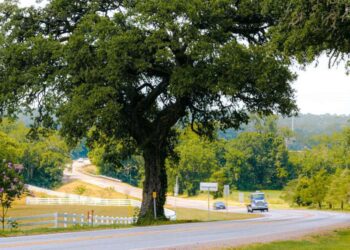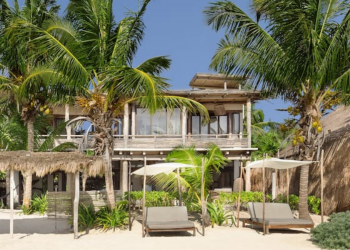The latest travel trend to inspire stargazing (literally) is landscape astrophotography – photographing the illuminated night sky and its celestial and astronomical wonders. To master the art of landscape astrophotography you’ll need to invest in a wide lens camera, night tracking gear, and setting up your photos to capture your surroundings in the foreground with the night sky, and then journey to the best nocturnal locations around the world. Luckily, we’ve mapped them out for you. Starlight, star bright, the first star I see tonight…
Landscape Astrophotography: Brecon Beacons, Wale
Counting Stars: Brecon Beacons in Wales is officially an International Dark Sky Reserve, recognized and protected for its nocturnal environment and lack of light pollution, which means you can explore deep space easily with a telescope and capture stunning astrophotography. On a clear night, you’ll see major constellations like the Milky Way, bright nebulae, and even meteor showers.
Best Place to Stay: Spend the night at Lanelay Hall Hotel and Spa a stylish 1800s Victorian mansion located near Cardiff South Wales. The rooms and onsite full Sir Christopher Cole Restaurant perfectly balance traditional Welsh styling with contemporary design.
Landscape Astrophotography: Death Valley National Park, CA, USA
Counting Stars: Death Valley, CA is one of our favorite U.S. National Parks for its pristine and picturesque desert landscape, along with its stargazing qualities, which are best experienced during a new moon (when light pollution is minimal). Death Valley is also the largest International Dark Sky Park in the United States and is classified in the “Gold Tier”, the best spots to shoot some landscapes are Harmony Borax Works, Mesquite Flat Sand Dunes, and Badwater Basin. To maximize your Astro view and ensure it’s not blocked by the mountains, find a spot in the open that has some elevation.
Best Place to Stay: Immerse yourself in the Californian desert vibe by staying right inside the park at The Oasis at Death Valley where you can choose from the historical four-diamond Inn at Death Valley or the Ranch at Death Valley.
Stargazing Destination: San Pedro de Atacama, Chile
Counting Stars: The Atacama Desert, a 990-mile strip of land on the Pacific coast that runs through Chile and Peru west of the Andes Mountains is known for its expansive view of the Southern Hemisphere night sky and a stunning view of the center of the Milky Way. There is a proposition to promote “Ethnic-Astro-tourism” also called Archeological Astronomy which guides guests to take an astronomical journey back in time to discover how the Andes’ ancient inhabitants explained the universe, the milky way, and the night sky. The “Likan Antay” or Atacama people had such a strong connection to the stars that their social structure was influenced by the stars. To explore its wonders, book the San Pedro de Atacama: Astronomical Tour through Get Your Guide to learn about the night sky from two different cultures and perspectives.
Best Place to Stay: Explora Atacama is a hotel located inside the Atacama Desert that serves as the perfect base for your exploration. The property also hosts over 40 explorations including hiking, horseback riding, in-house observatory, and stargazing observations through a professional telescope.
Stargazing Destination: Aoraki Mackenzie International Dark Sky Reserve, New Zealand
Counting Stars: The Aoraki Mackenzie is the only International Dark Sky Reserve in the southern hemisphere and covers the areas of Aoraki/Mt. Cook National Park and the Mackenzie Basin in New Zealand’s South Island. Known for its view of the constellation the Southern Cross, the Magellanic Clouds and the Milky Way. Aoraki Mackenzie is a Dark Sky Reserve due to outdoor lighting controls in place to minimize light pollution, conserve energy and protect the wildlife. A highlight is Mount John Observatory, considered New Zealand’s top astronomical research center, where you can observe 50 million stars each night, through the lens of one of the country’s biggest telescopes.
Best Place to Stay: Book a room at The Hermitage and immerse yourself in the heart of Aoraki/Mt Cook National Park. See the Tasman Glacier Ice Wall, take a guided hike along the Red Tarns Track and of course, big star gazing.
How to Master Landscape Astrophotography
First things first for any landscape astrophotography shoot, you’ll need a good camera, our pick is the Canon 90d and a wide lens, try Canon 50mm f/1.8 or Canon 10-22mm lens f/3.5-4.5. To complete your astrophotographer arsenal, you’ll need some specific gear like the Sky-Watcher DSLR Night Sky Tracker, which helps follow the specific area you want to photograph (remember the earth is constantly turning) so you can capture your target. It’s also a smart idea to invest in a telescope such as the Gskyer Telescope and a headlamp that has a red light to preserve your night vision without disrupting your astrophotography setup. As for the best camera bag, the Peak Design 20L provides easy access to your gear and ample storage. Astrophotography enthusiasts might also enjoy following these professional stargazers for more tips, tricks, and celestial dreaming, AstroBackyard, NightScaper, Astrofalls.






